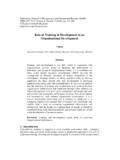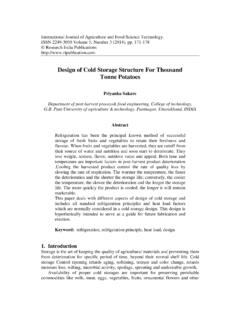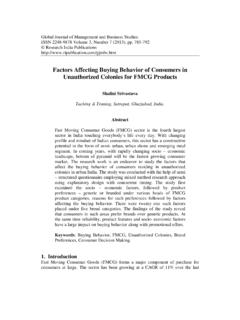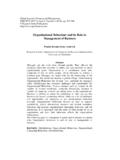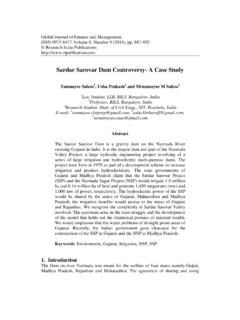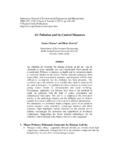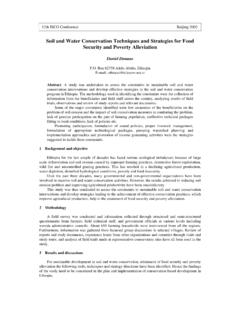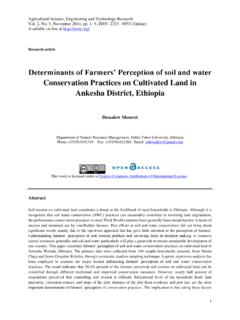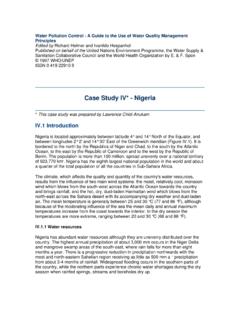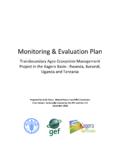Transcription of Role of Society and Government in the Sustainable ...
1 International Journal of Environmental Science: Development and Monitoring (IJESDM) ISSN No. 2231-1289, Volume 4 No. 3 (2013) Role of Society and Government in the Sustainable Development of water Resources of Hathras City: A Case Study Mubeen Beg1, Sultan Singh2, Salman Beg3 1 Department of Civil Engineering, AMU, Aligarh 2,3 Department of Civil Engineering, AMU, Aligarh ABSTRACT A study of the water resources and its management for the Sustainable development of Hathras City and adjoining villages has been carried out in this paper. Keeping in mind the rapid growth in population, industries, agriculture and change in the lifestyle of the Society , certain strategies are proposed in present paper for future Sustainable development of the Hathras City and adjoining villages. The strategies include education of Society in water conservation, soil conservation, ground water recharging, and water preservation reservoirs, implementation of stringent laws by the Government for maintaining the existing water resources afresh to provide adequate quantity of good quality water to the Society .
2 Keyword- Sustainable , development, Society , Government , NGOs 1. INTRODUCTION water and land are two components of vital resources of our country. Sustainable development of a country depends on better management of these two resources. India has a vast land and good water potential through rains. As far as Land management is concerned, more and more uncultivated lands can be transformed into cultivable land by employing soil conservation measures, however, optimal use of this land for food production is merely possible without water . Therefore, for Sustainable development of a region, an all out effort should be made to make available an ample quantity of water for the irrigation of lands for sufficient flood production. In addition to this water is an important element for other essential purposes which are directly associated with Sustainable development of a region like, navigation, hydroelectric power generation, industrial and domestic requirements.
3 The Sustainable development of country depends on adequacy of water needed for irrigation, power generation, navigations, industries, domestic requirements and wild life, A good irrigation system makes country self reliant in food requirements of the people. Good irrigation can t survive without adequacy of water . A major part of irrigation water requirement is fulfilled by direct rainfall during monsoon. India has a good water potential. However, some parts of India are subjected to flood while the other parts face drought simultaneously. Floods bring enormous loss of property and life and has an adverse impact on Environment, Ecology and Sociology and hence on Sustainable development of a country. Thus, on one hand, flood water goes west on the other hand it results in tremendous miseries to the people. If the flood water is saved from being lost, dual problems of flood protection of people and availability of water will be solved.
4 This can be achieved by employing flood water management measures like aquifers recharging, water harvesting, channel networking and better watershed management. Keeping this scenario in mind a case study of Hathras City and adjoining villages has been carried out for water management and their Sustainable development. 2. LITERATURE REVIEW The present and future status of water resources in many regions is closely monitored due to the pressures of climate; land cover and population change (Murray et al. 2012). Freshwater availability and consumption is of particular interest in India due to the country supporting an increasingly large population with decreasing per capita water supplies (Mall et al. 2006). Climate change offers the potential to significantly alter precipitation and surface water regimes in India ( ,Chattopadhyay and Hulme 1997; Kumar et ), while the anticipated population increase and expanding economy is expected to exacerbate stress on groundwater reserves ( , Amarasinghe et al.)
5 2007; Jain et al. 2007). As the region is among both the most intensively irrigated and densely populated in the world (Kumar et al. 2005), it is critical that water security is ensured in order to prevent the socio-economic adversities associated with water resource shortages. Of particular concern is north-west India, which is densely populated and identified by the Indian Ministry of water Resources (2006) as a region where groundwater extractions exceed recharge. Recent hydrological research regarding northwest India has largely focused on optimizing agricultural yields against the backdrop of increasing water stress. Groundwater resources in India have traditionally been assessed at the local scale through direct water table measurements ( , Naik and Awasthi 2003; Sharda et al. 2006) and electrical resistivity techniques ( , Israil et al. 2006). More recently, satellite-based gravity field retrievals of terrestrial hydrology have been employed for monitoring large-scale groundwater fluxes ( , Yeh et al.
6 2006; Strassberg et al. 2009; Syed et al. 2010). International Journal of Environmental Science: Development and Monitoring (IJESDM) ISSN No. 2231-1289, Volume 4 No. 3 (2013) 3. water RESOURCES AND Sustainable DEVELOPMENT Role of water Resources in Sustainable Development Without water , a harmonious and Sustainable development of socioeconomic activities is not possible. For purpose of improving the quality of life as a condition of achieving Sustainable development, it is essential to secure sufficient water of good quality throughout the community without upsetting the natural equilibrium of the environment. There is quantitative problem of water scarcity, particularly in developing countries. The aim of water management is to deliver the right amount of water at right time at the right place. It is an unfortunate fact that amount of fresh water that is available to any country on a long-term basis is nearly constant for all practical purposes.
7 Because of technical and economic considerations, only a certain percentage of total water available can be used at any specific time. However, total recycling or reuse is neither technically no economically possible. Role Awareness of Society in Sustainable Development The people in a Society are unaware about the dire consequences of pollution of water resources. In many localities, the public has connected their water closet pipes directly to the upper strata of earth. They do not realize that what they are feeding, they themselves will consume it, particularly poor people who rely on the upper strata for withdrawing water by hand pumps. Substantial amount of fresh water is lost due to public negligence or poor education of Society . People do not bother about the continuous over flow of overhead tanks and leakage in the water supply system. Obviously, all this causes loss of precious water resource and affect adversely the Sustainable development.
8 Therefore, Sustainable development is possible only if concerned people are fully aware, educated in maintaining water resources afresh. This awareness will alarm the peoples with critical situations viz., loss of water through manmade leakages in the distribution system, wastages of water in the households, unhygienic practices in the catchment area as well as pollution from point and non-point sources. This will lead to appropriate, judicious and equitable use of limited water sources at our disposal. This is achieved by adopting technologies such as recycling, reuse, cleaner and economic process. More than 90 million people add to the world s population every year Rouhollah Fatahi Nafchi, Hossien Banejad (2000). Human life relies on continuous access to fresh water and food resources. Food production, however is critically contingent upon the availability of water . Adverse Impact of Contaminated water Resources on Sustainable Development Safe water in sufficient quantities is fundamental to human health.
9 The most important water -associated health problem is diarrhea, accounting million of deaths per year, especially among children. Availability of safe drinking water , combined with sanitary facilities for disposal of feces and improved hygiene standards, could prevent diarrheal disease to a great extent in developing countries. Much emphasis has been placed on reducing biological contamination, but contamination from naturally occurring chemicals in groundwater and from industrial and agricultural waste is also becoming a serious problem in developing countries. In India, about 66 million people drink groundwater with too high a fluoride content. While arsenic is toxic and carcinogenic, fluoride is an essential element for development and protection of teeth and bones. In excess, however, fluoride leads to serious dental and skeletal deformities and other health problems. Installing filters or other devices at millions of tube wells to remove arsenic and fluoride is an almost impossible task.
10 Therefore, alternative sources of drinking water must be found in affected areas. In some regions, the availability of shallow groundwater for drinking is an increasing problem because of over exploitation for agricultural and industrial purposes. In some of the major areas of Asia, Such as the Punjab in India, water table is falling 2 to 3 meters a year. Groundwater depletion also causes the shallow drinking- water wells of poor communities to run dry, a problem that has received less attention. Deepening these wells is costly and beyond the resources of the poor. In the foreseeable future, many towns in developing countries like India will continue or expand the irrigation of high-value vegetable crops with untreated wastewater. Governments may wish to regulate reuse but are unable to offer practical solutions to the users. It is urgent, therefore, to develop a framework for evaluating different options and trade-offs so that governments and communities can make better-informed decisions.
